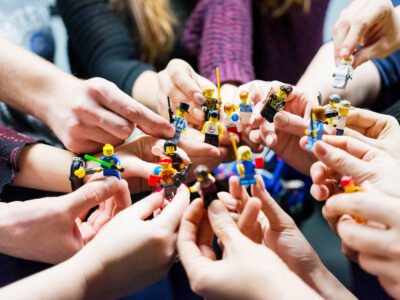How to Apply Innovation & Creativity to Problem Resolution
Develop innovative and creative solutions. Recognize problems and opportunities, and take initiative to generate and implement solutions that are effective and efficient.
Demonstrate flexibility, tolerance for ambiguity or unpredictability, willingness to take appropriate risks, and interest in exploring the unknown.
Understanding Innovation & Creativity
The process of creativity and innovation occurs in two stages: the creativity stage during which ideas are generated, followed by the innovation stage when those ideas are implemented toward improving existing procedures, approaches, or products – or creating new ones. [1] The notion of Innovation goes beyond that of Invention to involve the diffusion of the novel product or idea. [2]
While aspects of creativity are generally experienced at an individual level, innovation may occur at an individual, team, or organizational level and is often linked to an outcome, the result of the implementation process (e.g., economic, educational). [3] Fourteen key components of creativity have been identified as part of a proposed model to better evaluate creative practices (Figure 1).
Why does it matter?
In 2020, the World Economic Forum has ranked Creativity third – after complex problem solving and critical thinking – in the top 10 essential skills for success in the anticipated Fourth Industrial Revolution (e.g., emerging breakthroughs in artificial intelligence and The Internet of Things – any computerized device connected to the internet).[4][5]
As financial, environmental, political, and social crises persist, it is imperative to pursue creative and sustainable routes in order to conceive new strategies and tools for solving problems and accomplishing goals (e.g., electric cars to reduce carbon dioxide emission). [6][7] In fact, the United Nations 2030 Agenda for Sustainable Development emphasizes the implementation of technological innovations in the achievement of its 17-goal plan for a sustainable planet and population [8][9]
In the business world, Chief Executive Officers (CEOs) from 60 countries considered creativity as the single, most important personal attribute and a limiting factor for economic growth and future business success. [10]
Cultivating Innovation & Creativity
In educational institutions, organizations, or at home, cultivating innovation and creativity starts by securing a safe and healthy environment wherein individuals are encouraged to share and implement new ideas. [11] Promoting healthy habits in the workplace has been shown to increase employees’ creativity. [12] In fact, top employers such as Google (which has a “Chief Happiness Officer”) promote healthy practices by designating break zones for socialization, rest, and gaming; thus promoting a culture of creativity, innovation, and productivity. [13]
At the individual level, adopting a healthy lifestyle and engaging in recreational activities, such as listening to music, stimulate idea generation and boost creative thinking. [14] While creativity may invoke spontaneous idea generation, being creative in school or at work is rooted in the practical understanding of the problem you are trying to solve. In complex problem solving, creative idea generation entails the conjunction of two thinking processes: the exploration of many possible solutions to a problem (i.e., divergent thinking), followed by the organization of emerging ideas to make a decision on the best solution (i.e., convergent thinking). [15]
In his famous work on Creativity, Mihaly Csikszentmihalyi highlights the five steps for an effective creative process: [16]
1. Identifying a Problem.
Immerse yourself in a compelling problem that you deem worth solving. You may turn a crisis into an opportunity!
2. Gathering and Reflecting.
On relevant information and past uninvestigated solutions. Consult with experts as a way to get reliable information and perhaps inspiring advice.
3. Exploring the Problem.
Discover the roots of a problem by open-mindedly examining all possible layers. Identify the pain points (i.e., perceived or real problem requiring an innovative solution) by communicating with your potential clients/users to reach a satisfactory solution. Consider strategies for defining and assessing a problem: the 5 Whys, Cause, and Effect Analysis, and Root Cause Analysis.
4. Generating and Evaluating Ideas.
Use strategies such as Brainstorming to inspire ideas. Remember to maintain an open mind before dismissing ideas. The best discoveries and inventions often occur by “taking the road less traveled.” To examine different perspectives, try strategies such as the Six Thinking Hats or The Reframing Matrix. Choose criteria – such as risks, impact, product quality, or your team’s tolerance for change – to guide your evaluation. For instance, ask yourself: does the value of your ideas outweigh the time and money costs of implementation?
5. Implementation (innovation)
Commit to your idea(s) and create a business and communication plan to implement it. Get ready to be persuasive in selling your story to various stakeholders, including potential adopters (e.g., internal clients) or investors. Consider an authentic and compelling pitch about who you are as a team and the story of your product. What makes your product better than an existing one? What value does it add? Does it create a new market or solve an old but important problem?
Successful execution of your creative effort brings on motivation to repeat this process. Note that creativity is not a linear, unidirectional process. For example, new problems may arise along the way and can be addressed by going back to previous steps. As such, steps 1, 2, and 3 are continuously revisited. However, it is important to know when to stop your reflections and exploration of a problem and move on to the next step.
TRIZ (Russian acronym for the “Theory of Inventive Problem Solving”) is a systematic problem-solving tool to improve a product, process, or system. [17] This approach was conceived as a result of studying recurrent problem-solution patterns across various fields (e.g., management, chemical engineering, etc…) and resulted in 40 guiding principles to identify generalized solutions that could be applied to a particular problem. Check out TRIZ Journal and Oxford Creativity for more information on how to use this method.
Related: How to Use Design Thinking to Find Your Next Big Tech Startup Idea
Quick Guide to Innovation & Creativity
- Identify potential factors that may be positively or negatively impacting your creativity. To help you get started, here are examples of some factors known to influence creativity:
- Personal factors: your values, skills, and abilities, or the famous Big Five personality dimensions: conscientiousness, openness to experience, agreeableness, extraversion, and neuroticism, all of which influence creativity [18][19]
- Contextual factors: physical environment or your supervisor’s leadership style [20]
- Cultivate a wide range of idea creation methods and techniques (e.g., brainstorming, mind mapping) [21]
- Develop your interpersonal and presenting skills so that you can share your innovative ideas persuasively and overcome potential resistance to change [22]
- Be resilient and view failure as a learning opportunity [23]
- Challenge the status quo in thinking and the traditional viewpoints within an area [24]
Good Luck!
Source: mcgill.ca























